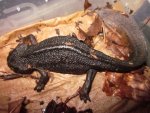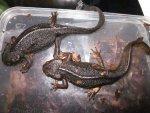- Joined
- May 7, 2007
- Messages
- 5,260
- Reaction score
- 114
- Points
- 63
- Location
- Hatfield, England
- Country
- England
- Display Name
- Julia
Today I have received, what I believe are two females. They are beautiful, but they are very much different to my Tylototriton verrucosus. I suspect they may be different type.
I would very much appreciate your views on these please.
I would very much appreciate your views on these please.






